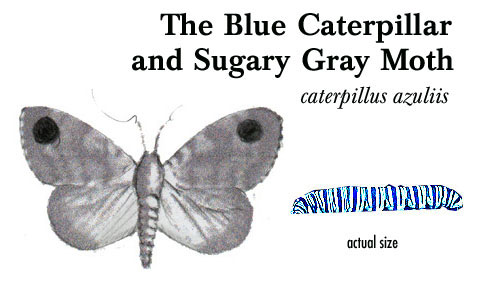
EXCERPT FROM
The Charmed Life:
The Story of a Boy Who Changes
By John Graham
|
WHEREIN THE EL FORNIO BLUE CATERPILLAR |

|
WHEREIN THE EL FORNIO BLUE CATERPILLAR |

LIKE THE SEVENTEEN YEAR CICADA, the El Fornio Blue Caterpillar had a habit of disappearing for many years before coming around again. Where it went was a matter of speculation to anyone who had ever lived in El Fornio. Few scientists had ever spent much time paying attention to the species, so information on Catapillosa azulis was scarce at best.
Long time residents who were fortunate enough to get a view of the critter were rewarded with the bright cyan blue daylight sheen it gave to a field of yellow mustard and milkweed. During the overcast days of June the species appeared as a soft blue snow across the hills. At night, the phosphorescent alkaloids in the caterpillar’s body caused a magnificent glow which the Spanish called “El Manton de la Virgin,” as if Mary herself had lain her blue shawl across the various hills graced by the caterpillar. And, indeed, it is El Manton, California which owes its name to this phenomena, and the various Campo Azul housing subdivisions located in the state. Cleverly enough, subdivisions with names like El Man-ton, Campo Azul, Oak Grove, Poppy Valley or Sycamore Canyon caused the destruction of the very thing they were named after—now there were only a dozen or so pockets of Blue Caterpillars left in El Fornio and those which remained were comprised of so few members that it was quite con-ceivably their last season every season.
Little has ever been collected about Catapillosa azulis. Easterner John Peabody from the Smithsonian Institute was the only scientist to have paid much attention to it. In 1914, on his way to Mount Parnassus to see Ishi, the so-called “Last Yahi Indian,” Peabody spent a summer observing some of the last large groups of the species, taking field notes and specimens as well as recording oral narratives from El Fornio locals—including members of both Juan Justo and Fernando Librado’s families. It was on this particular visit that Peabody spent time observing the El Fornio iguana as well. It was not until a year later that Peabody finally returned and finished up his work on both the caterpillar and iguanas, but the work was informal at best as Peabody was primarily an enthnologist and his study of these non-hominids a kind of hobby-on-holiday. Still, Peabody was a dedicated scientist and what work he has done is invaluable to this day for those who have picked up his studies.
Like the more famous Monarch Butterfly, the El Fornio Blue in its larval stage feeds off of the milkweed plant, Asclepias fasciclaris, which because it contains the alkaloid cardenolides renders the insect’s flesh bitter and toxic. It has no natural enemies and like many poisonous insects, emits a click discernable to many animals, particularly bats and birds, signaling undesirability even before an attack.
Unlike the Monarch which keeps its toxic status into winged adulthood, the Blue Caterpillar loses its poison and by the time it transforms into the indistinct gray moth of an adult, its taste is as sweet as powdered cereal—something the Fornay Indians knew well and took great advantage of. It retains, however, the click emissions of its caterpillar stage which continue to ward off potential predators.RELATED LINKS
Ishi the Last Yahi Indian
http://en.wikipedia.org/wiki/IshiJohn Peabody Harrington
http://nas.ucdavis.edu/NALC/JPHbio.html
www.mnsu.edu/emuseum/information/biography/fghij/harrington_john.html
http://en.wikipedia.org/wiki/John_Peabody_Harrington